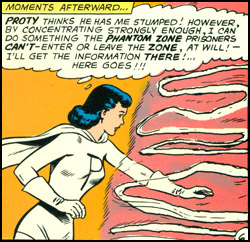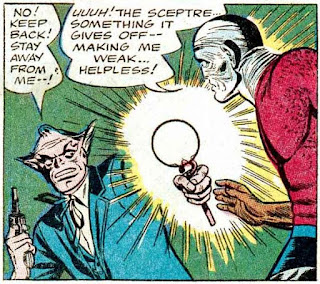[Roy] Thomas had an experience any comics fan or historian would kill for: He walked the offices of Marvel in the mid-’60s, when Lee and Ditko were working together on Spider-Man and Doctor Strange stories and Lee and Kirby were working together on nearly everything else, including The Avengers, The X-Men, and The Fantastic Four. Here’s the problem: It’s extremely unclear what “working together” meant....Kirby, from the time he left Marvel in 1970 until his death in 1994, swore up and down that Lee was a fraud on an even larger scale: Kirby said he himself was the one who had all the ideas for the Hulk, Iron Man, Thor, and the rest, and that Lee was outright lying about having anything to do with them. What’s more, he said Lee was little more than a copy boy, filling in dialogue bubbles after Kirby had done the lion’s share of the conceptual and writing work for any given issue. “Stan Lee and I never collaborated on anything,” Kirby told an interviewer in 1989. “It wasn’t possible for a man like Stan Lee to come up with new things — or old things, for that matter. Stan Lee wasn’t a guy that read or that told stories.”
At no time does Riesman suggest that Kirby might be exaggerating his claim to near-total creative input. Riesman does credit Lee with coming up with inventing Marvel's "shared universe" approach and with changing the game for all mainstream comics in terms of spoken dialogue, but he makes no argument against the verdict asserted by Kirby's longtime friend and confidante Mark Evanier:
“Unfortunately, from day one, Jack was doing part of Stan’s job, and Stan was not doing part of Jack’s job,” says comics historian Mark Evanier, who worked as Kirby’s assistant and has worked on and off with Lee since the 1970s.
So according to Kirby, he got a raw deal because Lee didn't share the writing-paycheck with him. According to an interview with Roy Thomas (to be identified LATER), Kirby invoked this injustice when he came back to Marvel in the 1970s, claiming that the only way he Kirby would collaborate with a writer would be if the writer wrote full-script descriptions of the stories, so that Kirby would only contribute the art. As most fans know, Marvel's editorial department consented to let Kirby write and draw all of his titles during his second contractual stint with Marvel. I suspect that Kirby knew that the Marvel editors valued his ability to draw vividly, without full-script constraints, and that his demand would lead, as it did, to his finally being able to collect both the artist and writer paychecks that he thought to be his due during the first contractual stint.
I don't begrudge Kirby that privilege, and even though I find little of his 1970s work palatable, from a historical perspective his solo work gives modern critics considerable information about the way he formulated stories when not interacting with another creative presence. What I do cavil at, though, is the idea promulgated by Kirby-- and championed by most anti-Lee writers, including Riesman-- that what Lee was doing was unique in the history of comics, or even Jack Kirby comics.
Here's an interesting aside on the way Kirby worked with another writer, taken from Mark Evanier's KIRBY: KING OF COMICS:
Kirby could do CHALLENGERS OF THE UNKNOWN without [Joe] Simon, and he did. A writer named Dave Wood provided scripts, which pretty much meant sitting with Kirby, hearing him spin off a plot, and the going home and typing it up. Jack rewrote whatever he was given anyway."-- KIRBY, page 101.Evanier does not cite his source for this view of the Kirby-Wood collaboration, but it's likely that his information came from Kirby. This narrative is probably as accurate a description of a 1957-59 working-relationship as anyone's likely to get after sixty years, but what I find most fascinating is that Kirby's creative process on CHALLENGERS, prior to any significant 1950s collaborations with Stan Lee, was essentially "the Marvel Method." This method meant that the writer simply discussed the plot very generally with the artist, after which the artist created his own version of the story, which might or might not owe anything to the writer's intentions-- at which point the only thing left to the official writer would be the dialogue.
So the question occurs to me, "Let's say that Jack Kirby did the lion's share of the work on CHALLENGERS; then where were his complaints about Dave Wood getting a full writer's paycheck?" I strongly doubt that Wood took anything but the full writer's check; no writer back then would have wanted to work with Kirby for less than the going rate, nor would DC Comics, whose relationship with Kirby was less than amenable, have made any special dispensations for Kirby.
And my answer is a cynical one. Kirby may have harbored some resentments back in the 1950s, but they never surface as they did with respect to Stan Lee for one simple reason: the Challengers were a penny-ante project that never showed-- and I suspect, never will show-- the potential to make Big Money in other media. By the time of Kirby's COMICS JOURNAL interview, there could be little doubt that the work he'd created at Marvel had such money-making potential. I surmise that even though Lee had no more rights to these properties than Kirby did, Kirby inflated the false issue of not getting paid for co-plotting, without mentioning that it was clearly the way he preferred to work.
In fact, though Riesman doesn't spot the discrepancy between what Kirby said he wanted and how he actually worked, Riesman sings the praises of the Marvel Method in terms of freeing comic-book artists from the tyranny of full scripts, and he quotes John Romita Sr, expressing sentiments that may well have mirrored those of Jack Kirby, at least back in his salad days:
“I realized that comics from a script was absolutely paralyzing and limiting,” says John Romita Sr., an artist who worked extensively with Lee in the ’60s and has remained a close friend ever since. “When you had the option of deciding how many panels you’d use, where to show everything, how you pace each page out, it's the best thing in the world. Comics becomes a visual medium!”
In the world of abstract moral judgment, maybe it was wrong for Kirby not to get co-plotting money for both his DC and his Marvel work. However, in terms of real-world interaction, I find it unlikely that any writer would have worked with Kirby under that arrangement-- and as I've said before, I don't think Kirby was capable of producing profitable comic books without writer-input, in any decade whatever.
I don't doubt, as I've said many times before, that Stan Lee has also made claims about his contributions that also lack substance. But when I see Kirby protesting his Marvel treatment with no perspective on how greatly the Stan Lee collaboration boosted his reputation in fans' eyes, I think that he, more than Stan Lee, may need to have his legacy more thoroughly interrogated.




























